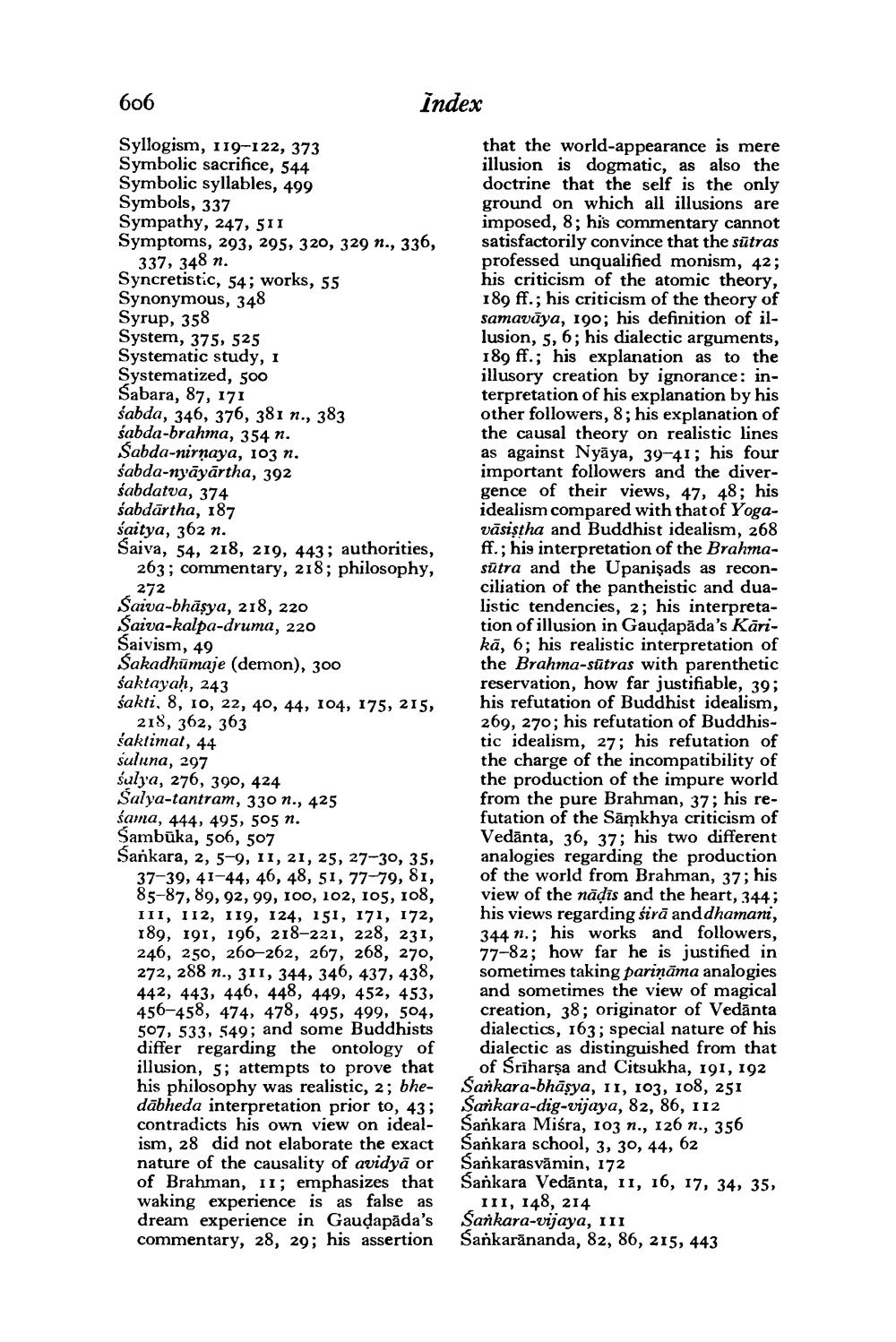________________
606
Syllogism, 119-122, 373 Symbolic sacrifice, 544 Symbolic syllables, 499 Symbols, 337
Index
Sympathy, 247, 511 Symptoms, 293, 295, 320, 329 n., 336, 337, 348 n.
Syncretistic, 54; works, 55 Synonymous, 348 Syrup, 358
System, 375, 525 Systematic study, I Systematized, 500 Sabara, 87, 171
sabda, 346, 376, 381 n., 383 sabda-brahma, 354 n. Sabda-nirnaya, 103 n. sabda-nyāyārtha, 392 sabdatva, 374
sabdartha, 187
saitya, 362 n.
Saiva, 54, 218, 219, 443; authorities, 263; commentary, 218; philosophy, 272
Saiva-bhāṣya, 218, 220 Saiva-kalpa-druma, 220
Saivism, 49
Sakadhumaje (demon), 300
śaktayaḥ, 243
sakti, 8, 10, 22, 40, 44, 104, 175, 215, 218, 362, 363
śaktimat, 44 suluna, 297
sulya, 276, 390, 424 Salya-tantram, 330 n., 425
sama, 444, 495, 505 n. Sambūka, 506, 507 Sankara, 2, 5-9, 11, 21, 25, 27-30, 35, 37-39, 41-44, 46, 48, 51, 77-79, 81, 85-87, 89, 92, 99, 100, 102, 105, 108, III, 112, 119, 124, 151, 171, 172, 189, 191, 196, 218-221, 228, 231, 246, 250, 260-262, 267, 268, 270, 272, 288 n., 311, 344, 346, 437, 438, 442, 443, 446, 448, 449, 452, 453, 456-458, 474, 478, 495, 499, 504, 507, 533, 549; and some Buddhists differ regarding the ontology of illusion, 5; attempts to prove that his philosophy was realistic, 2; bhedabheda interpretation prior to, 43; contradicts his own view on idealism, 28 did not elaborate the exact nature of the causality of avidya or of Brahman, II; emphasizes that waking experience is as false as dream experience in Gauḍapada's commentary, 28, 29; his assertion
that the world-appearance is mere illusion is dogmatic, as also the doctrine that the self is the only ground on which all illusions are imposed, 8; his commentary cannot satisfactorily convince that the sutras professed unqualified monism, 42; his criticism of the atomic theory, 189 ff.; his criticism of the theory of samavaya, 190; his definition of illusion, 5, 6; his dialectic arguments, 189 ff.; his explanation as to the illusory creation by ignorance: interpretation of his explanation by his other followers, 8; his explanation of the causal theory on realistic lines as against Nyaya, 39-41; his four important followers and the divergence of their views, 47, 48; his idealism compared with that of Yogavasistha and Buddhist idealism, 268 ff.; his interpretation of the Brahmasutra and the Upanisads as reconciliation of the pantheistic and dualistic tendencies, 2; his interpretation of illusion in Gauḍapada's Kärikā, 6; his realistic interpretation of the Brahma-sutras with parenthetic reservation, how far justifiable, 39; his refutation of Buddhist idealism, 269, 270; his refutation of Buddhistic idealism, 27; his refutation of the charge of the incompatibility of the production of the impure world from the pure Brahman, 37; his refutation of the Samkhya criticism of Vedānta, 36, 37; his two different analogies regarding the production of the world from Brahman, 37; his view of the naḍīs and the heart, 344; his views regarding sira and dhamani, 344 n.; his works and followers, 77-82; how far he is justified in sometimes taking parināma analogies and sometimes the view of magical creation, 38; originator of Vedanta dialectics, 163; special nature of his dialectic as distinguished from that of Sriharṣa and Citsukha, 191, 192 Sankara-bhāṣya, 11, 103, 108, 251 Sankara-dig-vijaya, 82, 86, 112 Sankara Miśra, 103 n., 126 n., 356 Sankara school, 3, 30, 44, 62 Sankarasvamin, 172
Sankara Vedanta, 11, 16, 17, 34, 35, III, 148, 214 Sankara-vijaya, 111
Sankarananda, 82, 86, 215, 443




